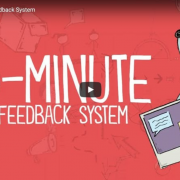How to Make Peer Feedback Meaningful in PBL
One of the reasons I love project-based learning is that students learn the content while also mastering critical soft skills. It’s a chance to develop student self-direction and ownership in the learning. This extends into the assessment process as well. Check out this sketch video I created about what it means for students to own the assessment process:
When students engage in meaningful peer assessment and self-assessment, they improve in their metacognition. They’re able to determine what they know, what they don’t know, and what steps they need to take next. This week, we’re going to tackle the topic of peer assessment and how we can do this well in a PBL unit.
This is an idea I explore in-depth in the Project-Based Learning Master Course. I devote two modules to the step-by-step process of designing self-assessments and peer assessments in PBL. If you’re a school-level or district-level leader, please fill out this form to find out more about our affordable bulk pricing options for both the introductory course and the master course.
Making the Most of Peer Feedback
I believe that peer feedback is critical for students. Part of this is the nature of peer interactions. Peers are often able to share their thoughts in a more relatable way than teachers. Another part is simply the time limits that teachers have. Even with student conferencing, teachers can only offer so much immediate feedback. However, with quality peer feedback, students can get an extra pair of eyes to figure out what they need to do next.
The following are a few examples of peer feedback protocols you can use with students:
- The 20-Minute Feedback System: This critical friends approach begins with one student sharing their work or pitching an idea while the other student actively listens.
- Structured Feedback with Sentence Stems: Here, you as a teacher provide specific sentence stems that your students can use to provide diagnostic, clarifying, or critical feedback.
- 3-2-1 Structure: This is simple. Students provide three strengths, two areas of improvement and one question that they have.
- Feedback Carousel: Each group gets a stack of sticky notes and offers anonymous feedback as they move from group to group.
- Peer Coaching: Students interview each other about the process, using the coaching questions from the student-teacher conferences to guide them if they struggle to come up with reflection questions.
When I mention this to fellow teachers, the first concern is usually time. We don’t want to burn an entire class period on peer feedback. The second concern is structural. We’ve all had times when students simply shrug their shoulders and say, “Looks good to me.” So, how do we pull it off? I remember a time I asked students to give peer feedback and a student wrote, “This is a great blog post. Also, it’s great. Did I mention how great it is. Wonderful job on the great blog post.”
In this moment, I realized that peer feedback doesn’t come naturally. We need to model the process for them and practice it together. We also need to help them understand how to give specific, targeted peer feedback. One of my favorite scaffolds for students is the peer feedback sentence stems. You can download these below:
 Download the Peer Feedback Sentence Stems
Download the Peer Feedback Sentence Stems
The 20-Minute Peer Feedback System
One of my favorite ways to have students engage in structured peer feedback is through the 20-minute peer feedback system. This consists of two 10-minute blocks where students walk through each part of the critical feedback process. None of this is new. This process (pitching, clarifying, offering feedback, paraphrasing, and coming up with next steps) has existed in many forms for years. So, I don’t claim to be original at all here. I’m just tossing out what’s worked for me. You can find it in the video below:
The way this works is simple. Members from different groups pair up and engage in a five-step process. Each step takes two minutes. You, as a teacher, can keep a timer going and say, “next” when it is time to move to the next phase. In the first phase, the first partner gives an“elevator pitch” sharing the product. Next, the second partner asks clarifying questions while the first partner answers the questions. The rule is that there cannot be any feedback given. It has to be question and answer. Afterward, they move into the feedback stage, where the second partner gives specific feedback. This is followed by paraphrasing. Finally, they land on next steps. When this is done, the partners switch roles.
 Download the 20-Minute Peer Feedback System
Download the 20-Minute Peer Feedback System
Mastermind Groups
Mastermind groups are another option for peer feedback. Unlike the 20-minute Peer Feedback System, these require a significant time commitment. Also, members meet with people outside of their PBL groups to share ideas, set goals, and ask for feedback. This can help prevent groupthink and spark innovation. However, they tend to work best with longer projects at an older age group. I would recommend Mastermind Groups for courses that are designed around PBL, where students have a higher sense of ownership from the start.
If you’re unfamiliar with Mastermind Groups, here is a basic overview:
The following are a few of the things students might do as they meet with your Mastermind Group:
- Share your journey with the group and let them hear what you are learning along the way
- Share your needs with others and ask for ideas or resources
- Share your frustrations (there’s a power to being vulnerable)
- Share your success stories and celebrate the success together
- Talk about potential collaboration options together




Leave a Reply
Want to join the discussion?Feel free to contribute!